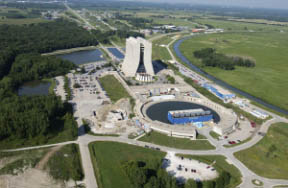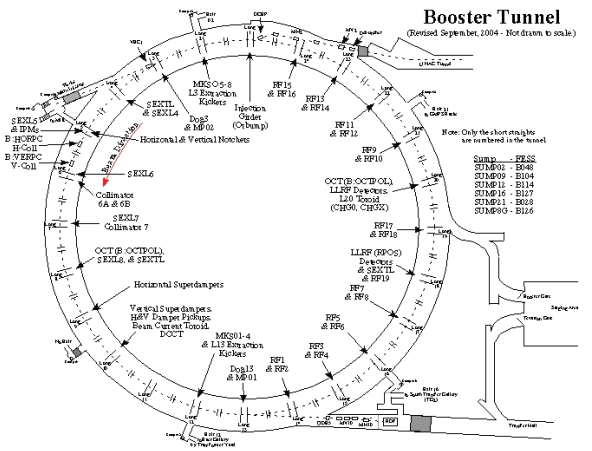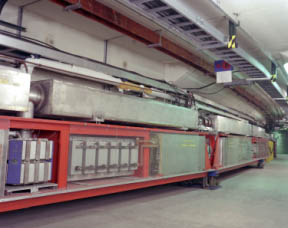|
 |
The Booster is the third accelerator in the Fermi chain of accelerators. It takes 400 MeV H- ions from the Linac (through the 400 MeV transfer line), strips the electrons off, accelerates the remaining protons to 8 GeV, and then sends them via the 8 GeV line to the Main Injector.
The Booster accelerator is a 150-meter diameter proton synchrotron. It is considered a "fast cycling" machine, cycling at 15 hertz. The Booster is made up of 96 magnets. Its tunnel is 8 feet high and 10 feet wide, covered by 15 feet of earth shielding.
|

400 MeV Transfer Line
The 400 MeV line transport line provides matching of each machine's lattice. The line must also lower the beam to the Booster, which is about 15 feet below the Linac. Injection into the Booster takes place at period 1.
The Booster chopper, along with most of the 400MeV transfer line, is located in the Linac tunnel. It determines the portion of the beam pulse sent to Booster.
Dipoles and quadrupoles steer beam along the 400 MeV line.
Injection into the Booster
The 400 MeV line intersects the Booster ring at the injection girder, where a septum magnet removes the horizontal bend angle. Beam is directed parallel to the Booster beam, but about 8 cm outside of the Booster orbit. The Booster beam passes through a field-free region of the septum magnet. Both injected and circulating beams pass through the upstream Orbump magnet. This magnet bends the circulating beam outward and the injected beam inward so that they overlap. Remember that the injected and circulating beams are of opposite polarity; the circulating beam is made up of protons, while the injected beam is still H- ions. The injection centers the beam on a stripping foil located between the second and third Orbump magnets. The H- ions and circulating beam passes through the stripping foil, which removes the electrons from most of the H- ions. The "electron catcher" captures the stripped electrons. The two downstream Orbump magnets then bends the remaining proton beam inwards to the Booster orbit. The unstripped H- ions are bent outward. The stripping foil used in removing the two electrons from the H- ions is made of a thin layer of carbon.

Extraction
Beam can be extracted from Booster at two locations, depending on its destination. An extraction at Long 13 transfers beam to the Booster dump. An extraction at Long 3, initiated by kickers in Long 2, transfers beam to the Main Injector via the MI-8 transfer line.
 Magnets
Magnets
The magnets are built by stacking some 4400 silicon steel laminations (0.025? thick) together and bonding them with epoxy resin. These are "canned" magnets, which means the laminations are inside the vacuum container. The container in this case is made of thin, stainless steel sheets welded to the outside of the laminations. The laminations are stacked in such a way that magnets have the curvature of the beam path. In addition, end laminations are tapered to create a small sextupole field that reduces the chromaticity. These are dual function magnets; they bend like a dipole magnet and focus like a quadrupole magnet. The completed magnet has a cross section of 13 inches by 18 inches and is 10 feet long. The magnet assembly weighs approximately 5 tons.
RF
The application of RF energy accelerates the Booster beam. The beam receives this energy as it passes through each of the 18 ferrite-tuned accelerator cavities located around the Booster ring. A 100 kW Power Amplifier drives each cavity.
There are 84 stable phase space areas, called buckets, where beam may be captured and accelerated. A bucket may exist with or without beam. The beam captured within a bucket is referred to as a bunch.
RF acceleration in the Booster begins with the beam being captured. This capture is accomplished by letting the Linac beam lose its RF structure and then circulate in the ring without acceleration. The Debuncher cavity in the 400 MeV line reduces the momentum spread of the injected beam by slowing the early arriving particles and speeding up the late arriving particles. After all the injected beam is circulating, adjacent stations are brought into phase over a period of 200-300 nanoseconds; this process is called paraphasing.
LCW
Cooling water dissipates heat generated by the resistance of the magnet assemblies and power supplies. The cooling water and the bus share the same path, with the water traveling through a whole down the middle of the bus. There is a potential problem with using normal tap water and circulating it through the magnet bus. Electrolysis, the conduction of electricity through water, would occur where large voltages exist and would damage the metals used in the bus-work and magnet windings. Low Conductivity Water (LCW) prevents this from happening.
LCW also cools the other numerous heat loads associated with the Booster both in the galleries and in the tunnel. The Booster 95 degree LCW system provides the majority of the cooling. There is also a glycol cooling system used for the anode power supplies (which are located outside) that heat-exchanges with the 95-degree system.
Accelerator Update Archive
More Information
For Tevatron luminosity charts and the current status of Fermilab's
accelerators and detectors (live!), please go to Fermilab Now
Comments and Suggestions
What do you think about the Accelerator Updates? Please send comments and suggestions to: accelupdates@fnal.gov.
| 


 Magnets
Magnets